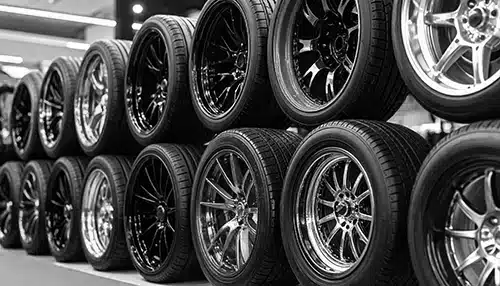Understanding Muscle Car Wheels
Muscle car wheels are more than just functional components—they're an integral part of your classic vehicle's character and historical authenticity. From the iconic Rally wheels of 1960s Chevrolets to the Magnum 500s that adorned countless Fords and Mopars, these distinctive wheel designs helped define the golden era of American performance.
Whether you're restoring a treasured classic to showroom condition or building a restomod with period-correct styling cues, choosing the right wheels can make or break your project's overall aesthetic and authenticity.
Popular Muscle Car Wheel Styles
Factory Original Styles
Many muscle car enthusiasts prefer factory-original wheel designs to maintain authenticity. These include:
- Rallye Wheels - Used on many GM vehicles including Chevelles, Camaros, and GTOs, featuring a simple steel design with small vents and chrome trim rings
- Magnum 500 - Iconic 5-spoke wheels found on many Ford, Mercury, and Mopar muscle cars
- Styled Steel Wheels - Factory options for many manufacturers featuring decorative patterns and chrome accents
- Mopar Road Wheels - Distinctive 5-spoke design often seen on Dodge and Plymouth muscle cars
- SS Wheels - Chevrolet's simple yet classic design for many of their Super Sport models
Aftermarket Performance Wheels
Period-correct aftermarket wheels that were popular during the muscle car era include:
- American Racing Torq Thrust - The quintessential 5-spoke muscle car wheel
- Cragar SS - Chrome 5-spoke wheels that became synonymous with street performance
- ET Mags - Popular slotted mag wheels
- Keystone Klassics - Distinctive 5-spoke design with a deep dish look
- Weld Racing Wheels - Lightweight performance designs for serious drag racers
Muscle Car Wheel Specifications
Sizing Considerations
Original muscle car wheels typically came in smaller diameters compared to modern vehicles:
- Wheel Diameter: Most muscle cars came with 14" or 15" wheels from the factory
- Wheel Width: Factory widths typically ranged from 6" to 8", with wider wheels for performance applications
- Backspacing/Offset: Critical for proper fitment and clearance with suspension and brake components
- Bolt Pattern: Varies by manufacturer (Chevrolet 5x4.75", Ford 5x4.5", Mopar 5x4.5")
Wheel Sizing Tip
When upgrading to larger diameter wheels, consider a "plus-sizing" approach that maintains the overall tire diameter to preserve proper speedometer reading and drivetrain performance.
Materials and Construction
Original muscle car wheels were typically made from:
- Steel - Durable and period-correct for many applications
- Aluminum/Magnesium Alloys - "Mag wheels" reduced unsprung weight for better performance
- Composite - Some designs featured steel centers with aluminum outer rims
Choosing the Right Wheels for Your Muscle Car
Restoration vs. Restomod Considerations
Your approach to wheel selection should align with your overall project goals:
- Concours Restoration: For show-quality restorations, only factory-correct wheels with proper date codes will suffice
- Driver Restoration: Reproduction wheels that maintain the original look but may offer improved quality and durability
- Restomod: Period-inspired designs available in modern sizes for improved handling and brake clearance
Popular Muscle Car Makes and Their Wheel Options
| Make | Popular Models | Common Factory Wheels | Popular Upgrades |
|---|---|---|---|
| Chevrolet | Camaro, Chevelle, Nova | Rally Wheels, SS Wheels | Torq Thrust, American Racing VN500 |
| Ford | Mustang, Torino, Fairlane | Magnum 500, GT Wheels | Cragar SS, American Racing Shelby |
| Dodge/Plymouth | Charger, Challenger, Road Runner | Road Wheels, Rallye Wheels | Magnum 500, Keystone Klassic |
| Pontiac | GTO, Firebird, Trans Am | Rally II, Honeycomb | American Racing Daisy, Torq Thrust |
Key Takeaways: Muscle Car Wheels
- Period-correct wheel selection is crucial for maintaining your muscle car's authentic appearance
- Factory original wheels typically came in 14" or 15" diameters with widths from 6" to 8"
- Popular styles include Rallye wheels, Magnum 500s, and aftermarket classics like Torq Thrusts
- Consider your restoration goals when selecting between original, reproduction, or modern interpretations
- Proper fitment requires attention to bolt pattern, offset, and brake clearance
Frequently Asked Questions About Muscle Car Wheels

Can I install larger diameter wheels on my classic muscle car?
Yes, many muscle cars can accommodate wheels up to 17" or 18" in diameter with proper attention to offset, backspacing, and tire profile. However, you may need modifications to your wheel wells, suspension, or brakes depending on your specific vehicle.
What's the difference between original and reproduction muscle car wheels?
Original wheels were manufactured during the muscle car era and have proper date codes for concours restorations. Reproduction wheels offer the same appearance but with modern manufacturing techniques, often providing better quality and durability while maintaining a period-correct look.
How do I determine the correct bolt pattern for my muscle car?
Bolt patterns are typically specified as the number of lugs followed by the bolt circle diameter. For example, a "5x4.75" pattern has 5 lugs on a 4.75" circle. Most GM vehicles use 5x4.75", while Ford and Mopar typically use 5x4.5". Measuring existing wheels or consulting factory specifications will ensure proper fitment.
Are original steel wheels better than aftermarket aluminum wheels?
Each has advantages. Steel wheels offer period-correct authenticity and durability, while aluminum wheels reduce unsprung weight for better performance. For show cars, factory-correct steel wheels may be preferred, while drivers may benefit from aluminum's performance advantages.
Can I mix and match different wheel styles on my muscle car?
While traditional staggered setups (wider wheels in the rear) were common in the muscle car era, mixing completely different styles wasn't typical. For an authentic look, it's best to use matching wheels all around or a staggered setup with the same style.
Find Your Perfect Muscle Car Wheels
Performance Plus Tire, offers a wide selection of authentic muscle car wheels for your classic restoration or restomod project. From factory-correct reproductions to period-inspired modern designs, we have the right wheels to make your muscle car stand out. Shop Muscle Car Wheels.